The fate of Volga Bulgaria
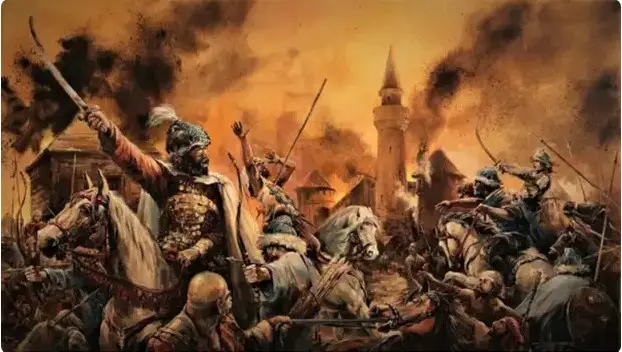
I. Aidarov. Fall of the Great Bulgar
В previous article it was told about the completion of the famous western campaign of the tumens Subedei and Jebe, the defeat of the seemingly invincible Mongols on the banks of the Volga and the return of the remnants of this corps to Genghis Khan. And what happened next?
Mongol conquest of Volga Bulgaria
Just 6 years later (in 1229) - after the election of Ogedei as the great khan and the appointment of the ruler of the ulus of Jochi Batu, a 30-strong Mongol army again invaded the territory of Bulgaria and its vassals. Here the Mongols met stubborn resistance, and they managed to completely conquer these lands only in 1236. At the last stage of the war, the invading army was led by Subedei, who fought in Western China from 1229 to 1232. But he, according to the “Secret History of the Mongols,”
As a result, in 1234 Ogedei was forced to issue a decree on the mobilization of forces throughout the empire - the last in stories of this country:
The youngest son of Genghis Khan Kulkan, the sons of the Great Khan Ogeedei Guyuk and Kadan, his nephews Batu, Ordu, Shiban and Tangut (sons of Jochi), Mengu and Buchek (sons of Tuluy), Buri and Baydar (sons of Chagatai), were to take part in the new campaign. as well as Subedey-bagatur and Burundai-batyr (the future triumphant in the battle on the Sit River, in which Grand Duke Yuri Vsevolodovich of Vladimir died).
Batu Khan was appointed nominal commander-in-chief, but real power over the army was in the hands of Subedei. The decisive offensive began in the late summer of 1236. The main cities of Volga Bulgaria - Bulgar and Bilyar - fell. Most of the Bulgar aristocrats then recognized the power of the Mongols and stopped resistance. According to some reports, it was the Bulgars who knew how to fight in forest areas who played a decisive role in the encirclement and defeat of Yuri Vsevolodovich’s army in the City.
Mentioned in previous article The Mordovian prince Purgas took his last battle 30 km from modern Penza, in a fortress called either Burkas or Sernya - now in its place is the Zolotarevskoye settlement, where the remains of about 2 thousand people were found.
Another Mordovian prince, Puresh, went over to the side of the Mongols and took part in the Western campaign of Batu Khan. Apparently, the Mongols used them as “cannon fodder.” Matthew of Paris, referring to the testimony of captured Tatars, wrote about the Mongol army:
The ending was sad: having suffered huge losses, on April 8, 1241, the Mordovians refused to take part in the famous Battle of Legnica, which took place the next day.
Subedei ordered Puresh to take his army to the rear, supposedly for rest, giving weapon The troops that took their place at night killed the Moksha prince, his son Atyamas and all the Mordovians. According to a popular legend, Puresh's daughter Narchatka (Narchat), having learned about the death of her father and brother, raised an uprising in 1242, which was brutally suppressed by the Mongols.
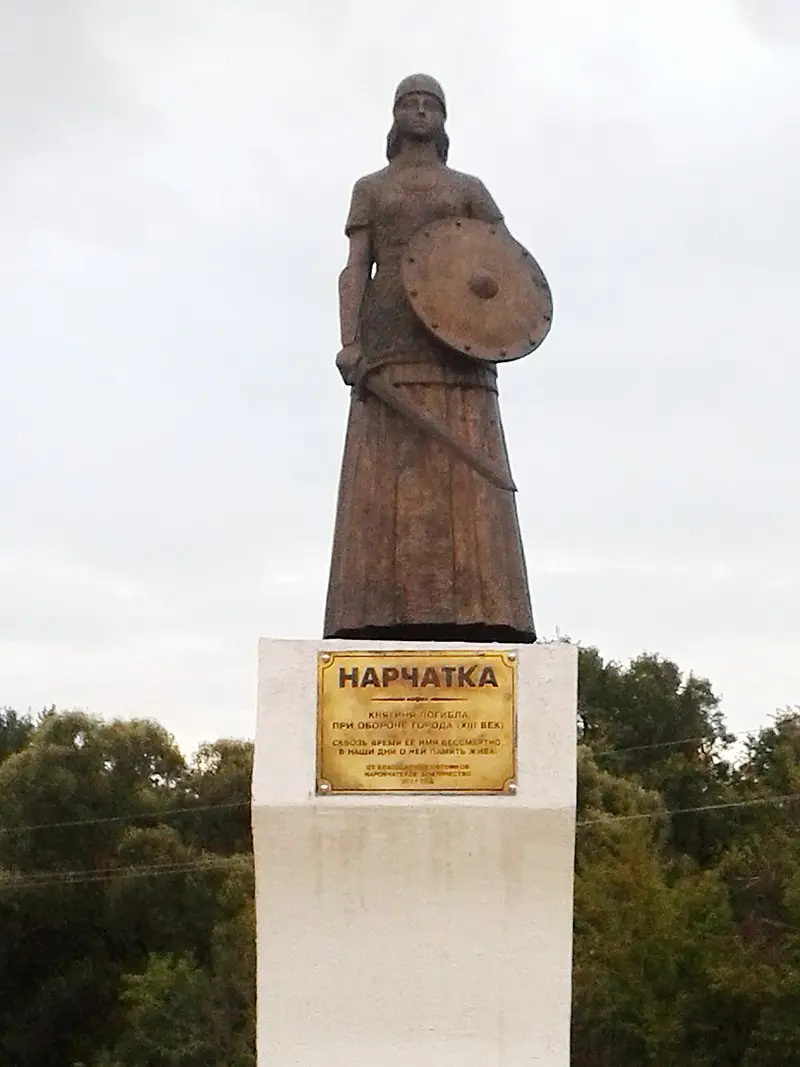
Monument near the village of Narovchat
Some believe that it was then (and not in 1236) that the Sernya (Burkas) fortress, besieged by the Tatars, perished, on the site of which the Zolotarevskoye settlement is located.
Volga Bulgaria became one of the Horde uluses. Before the founding of Sarai Batu, the capital of the Jochids was the city of Bulgar, in which, according to Karamzin, in addition to the Volga Bulgars lived
The emergence of the Kazan kingdom
In 1395, the Bulgar cities on the Volga were devastated by the troops of Tamerlane, which led to a long period of decline of these lands. In 1438, the Golden Horde Khan Ulu-Mukhammed (“Greater Muhammad”), the Khan of the Golden Horde and Crimea, having been defeated by Kuchuk-Mukhamed (“Lesser or Small Muhammad”), founded a new state on the site of the Volga Bulgaria and the Chuvash land, which occupied the territory from Vyatka to the Volga and from the Oka to the Kama and the mouth of the Belaya River. In the Kazan Chronicler you can read:
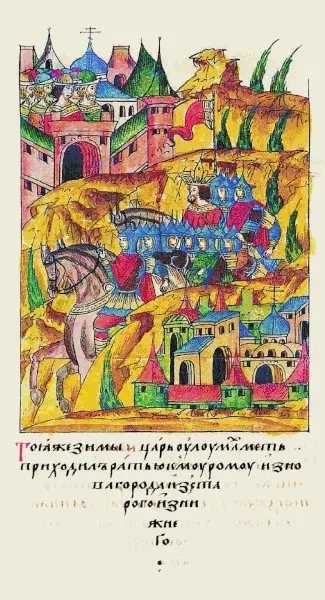
Ulu-Muhammad on the miniature of the Facial Vault during the campaign against Murom
The borders of the Kazan kingdom in the south reached modern Volgograd, in the north they ran along the Pizhma River (from its mouth to the mouth of the Voya River), along the Vyatka River to the upper reaches of the Kama, in the west the border was the banks of the Volga and Sura, in the east the Kazan Kingdom bordered on the Nogai Horde . Moreover, the subjects of the Kazan kings were not nomads, but farmers. The secular Russian writer of the 16th century Ivan Peresvetov wrote:
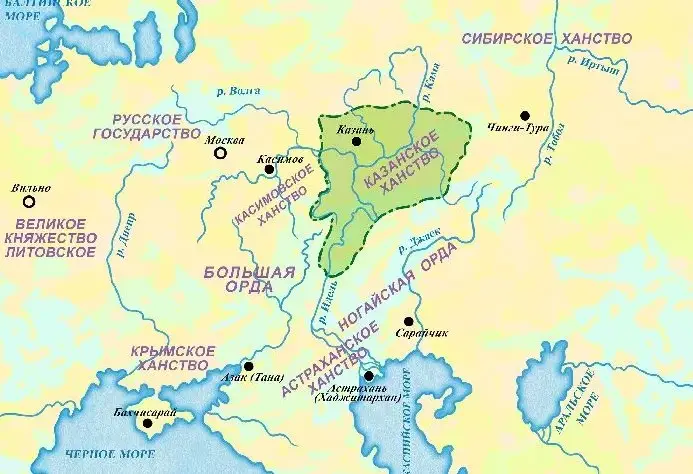
Kazan kingdom on the map
However, some believe that the true founder of this state was the eldest son of Ulu-Muhammad Mahmud (Mamotyak), who, according to the Resurrection Chronicle:
The Nikon Chronicle reports the same thing:
That is, here the eldest son of Ulu-Muhammad appears in the role of the Prophetic Oleg - like the famous prince, he kills the ruler of Kazan on the grounds that he is not a member of the ruling dynasty.
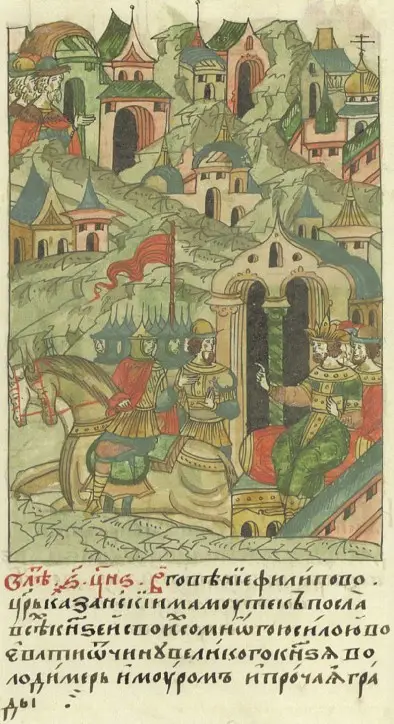
Mamutyak sends his army to Moscow
One way or another, the capital of the state, founded either by Ulu-Muhammad or his son, became the city of Kazan, which is believed to have been one of the border fortresses of Volga Bulgaria. Despite the “millennium” celebrated in 2005, Kazan was first mentioned in a historical source only in 1391. After this city, the new state began to be called the Kazan Kingdom (Khanate). During its existence, in addition to minor border skirmishes and raids, 11 major wars with the Russian state were recorded, 6 of them were started by Kazan citizens, 5 by Russians.
The first campaign of the Kazan people against the Russian lands took place in 1439; the Moscow and Tver Chronicles report that the Khan’s troops failed to take Moscow, but they pretty much plundered the surrounding area. And in 1444, Nizhny Novgorod was captured by the Kazan people. When trying to recapture this strategically important city, on July 7, 1445, the troops of Vasily II were defeated by the army of the already mentioned son of Ulu-Muhammad, Mahmud. Among others, the Grand Duke and his cousin Mikhail Vereisky were captured. Then Suzdal was also plundered.
In terms of its consequences, this was one of the most terrible and humiliating defeats of the Russian troops from the Tatars. The amount requested for the release of the Grand Duke was so great that the state did not have the money to ransom other prisoners, who were eventually sold on slave markets.
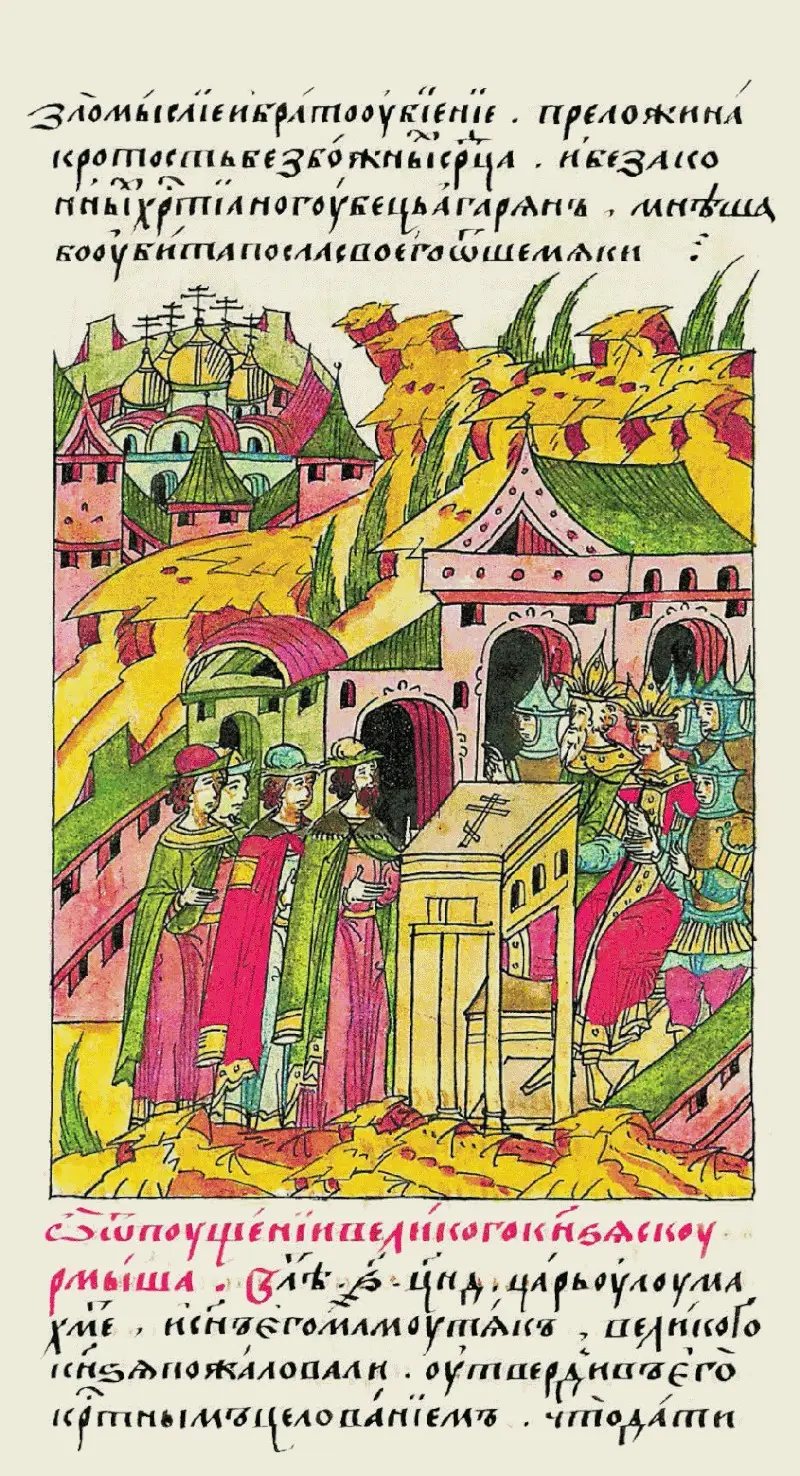
Vasily II swears on a crucifix to pay a ransom, miniature of the Facial Vault
There were even rumors among the people that the Grand Duke ceded Moscow to the Kazan Tsar.
Vasily II had to agree to the construction of mosques in Russian cities and transfer Gorodets Meshchersky to the Kazan princes Kasim and Yakub “to feed,” which became known as the Tsarevich Town - and then the name Kasimov was assigned to it. For all this, the Grand Duke was publicly reproached by his rival, Dmitry Shemyaka, who then ordered Vasily II to be blinded (and this prince went down in history under the nickname “Dark”).
Karamzin wrote that “five peoples lived in the Kazan kingdom: Mordovians, Chuvash, Votyaks (in the Arsk region), Cheremis and Bashkirs.” And also that the “Mughals” and “Bulgars” “made up one people, the remnants of which are now called the Kazan Tatars.” However, only the ruling dynasty of the Chingizids was Mongolian (Tatar) in this state. Tsars (khans) in Rus' were often called Kazan, their subjects - Kazan or Kazan Tatars. Thus, in the Resurrection Chronicle under 1478 it is reported:
And here is the chronicle message about the raid of 1537:
In 1469, the Russians managed to take revenge for the defeats of 1444–1445, and in 1487, the army of Ivan III took Kazan by storm, and the pro-Moscow khan Muhammad-Emin sat on the throne there.
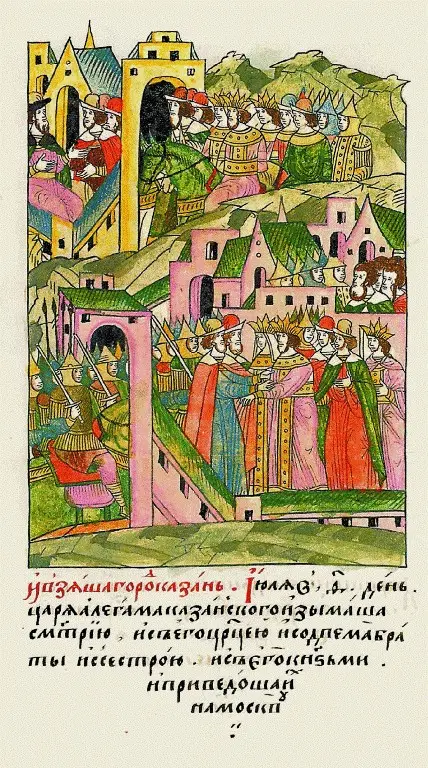
Miniature of the Facial Vault, illustrating the capture of Kazan by Ivan III in 1487.
The text at the bottom of this thumbnail reads:
After this victory, Ivan III began to call himself as follows: “Grand Duke of Vladimir, and Moscow, and Novgorod, and Pskov, and Tver, and Ugorsk, and Vyatka, and Perm, and Bulgaria, and others” (for example, in a contract document with Roman Emperor Maximilian).
Please note: Ivan III still calls himself the Bulgarian Prince, and this is a symbolic title - without territories, and the land of the former Volga Bulgaria was owned by the Kazan Chingizid kings.
In 1521, Sahib Geray, the brother of the Crimean Khan Mengli Geray, came to power in Kazan: the Kazan people made a joint campaign against the Russian lands, uniting their troops near Kolomna and forcing Vasily III to first hide in a haystack and then flee to Volokolamsk.
In 1532, Vasily III managed to place the pro-Moscow Khan Jan-Ali on the Kazan throne. But in 1535, Vasily’s protege died, and a representative of the Crimean dynasty, Safa-Girey, again came to power in Kazan.
The Kazan Gireys (Gerai), who were allies of the Crimean Khanate, were principled opponents of the Moscow state, and in 1521–1547. About 40 raids on Russian lands were recorded. The number of Russian slaves on the territory of this Khanate reached 100 thousand people. When, under the terms of the peace treaty concluded after the Second Campaign of Ivan the Terrible, the people of Kazan undertook to release them, in Sviyazhsk alone food was allocated to 60 thousand people returning to their homeland.
The problem of the Kazan threat was finally resolved by Ivan IV, who made three campaigns against this khanate and annexed it to the Russian lands in 1552. By the way, along with the Russian troops, Tatar detachments from the Kasimov Khanate, which was already in vassal dependence on Moscow, also went to Kazan.
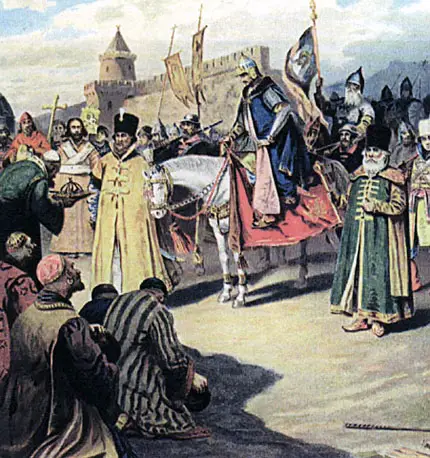
P. Korovin. Capture of Kazan
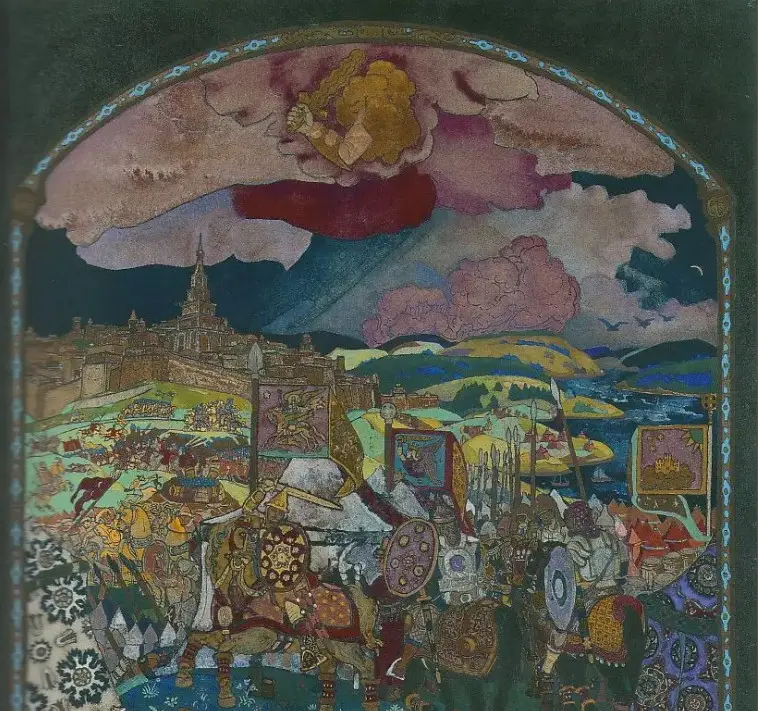
N. Roerich. Conquest of Kazan (sketch of a panel for the Kazansky railway station in Moscow)
The inhabitants of the conquered lands professed Islam, which did not prevent the Orthodox Christian Ivan IV from declaring himself Tsar of Kazan. This title then passed to the Godunovs and Romanovs.
The last Tsar of Kazan was Nicholas II, and this title is the sixth in a row. This monarch also retained the title “Prince of Bulgaria” assigned by Ivan III. But Nicholas II was not the Khan of Khiva and the Emir of Bukhara - these states had the status of protectorates of the Russian Empire, and until 1920 their own dynasties ruled there.
Kazan people
But let's return to the banks of the Volga. Kazan "Tatars" often called themselves simply Muslims. By the way, this is exactly what Bosniaks who professed Islam were officially called Muslims in socialist Yugoslavia.
Another self-name of the subjects of the Kazan kings is “kazanly”, that is, Kazan people. By the way, we can also recall the expression “orphan of Kazan”, which, according to the most reliable version (put forward by V. Dahl), appeared after the capture of Kazan by Ivan the Terrible - this is how noble people of the khanate called themselves in petitions to this king. Their imaginary “poverty” was ironically played out: “orphan of Kazan” - “orphan of Kazan”, that is, feigned. And then these two expressions were combined - and precisely in the first version. Let us clarify that the word “orphan” at that time was a derivative of “sir” and meant “poor, wretched person”, not necessarily lonely or left without parental care. Until the 15th century, it was often used as a self-name for Russian peasants.
It should be noted that in Rus' they knew very well that in Kazan, Astrakhan, Sarai, Crimea or Siberia there live different peoples who even speak different languages and only understand each other with difficulty. The Kazan people, for example, spoke the Turkic language of the Altai family of the Kipchak subgroup - “closely related” are the Kumyk, Balkar, Kazakh, Bashkir, and Kyrgyz languages.
And the Krymchaks spoke the language of the Oguz subgroup, which is closer to Turkish, Gagauz, Turkmen, Azerbaijani and Salar. And there were also “Nogai Tatars” (Nogais), “Mountain Tatars” (Karachais and Balkars), “Yenisei Tatars” (Khakas), “Lipka Tatars” (Polish-Lithuanian, Belarusian), “Dobrudzhan Tatars” and so on. Modern Azerbaijanis were known as "Caucasian Tatars", and Marietta Shahinyan used this "definition" even in 1935 - in the fantasy revolutionary novel "Mess-Mend".
In general, we can safely say that the word “Tatars” in the Russian lands in those days was actually synonymous with Muslims: Kazan Muslims, Crimean Muslims, and so on.
If we talk specifically about the Kazan “Tatars”, then we remember that, according to Karamzin, people of 5 tribes originally lived in the Kazan kingdom. After the annexation of Kazan to the Russian state, numerous settlers from Russian regions appeared.
In the Russian Empire, little attention was paid to nationality; belonging to a religious denomination was much more important. The concepts “Orthodox” and “Russian” were practically synonymous: having been baptized according to the Orthodox rite, Muslims, Catholics, Protestants or Jews immediately became Russian.
The Tatar Murza Solohmir, having converted to Orthodoxy, instantly turned into the Ryazan boyar Ivan Miroslavich, married the sister of the famous Prince Oleg Ivanovich, Anastasia, and became the founder of the noble families of the Apraksins, Rataevs, Kryukovs, Shishkins, Chebotarevs and some others.
The Astrakhan prince Murtaza-Ali, having been baptized, became the Moscow boyar Mikhail Kaibulovich, married Agafya Ivanovna Sheremeteva (great-granddaughter of the Khan of the Great Horde Akhmat), and in 1572 headed the Boyar Duma.
Do you remember the answer of Nicholas I to de Custine?
After the conquest of the Kazan kingdom by Ivan the Terrible, all Muslims began to be called “Tatars”, and all Orthodox Christians were called “Russians”. This division, not on a national basis, but on a religious principle, still exists, although it is almost impossible to distinguish a modern Kazan Tatar from a Kazan Russian.
A similar situation, by the way, was in the Balkans, where Orthodox Christians became Serbs and Montenegrins, Catholics became Croats, Muslims became Bosniaks. And children from mixed marriages during Tito’s reign called themselves Yugoslavs.
But let's return to the Kazan Tatars.
Currently, when studying their genotype, it turned out that they have much in common with the inhabitants of Eastern Europe and the Mediterranean. As for the “contribution” of immigrants from Central Asia to the ethnogenesis of the population of this republic, in different regions it ranges from 1% to 6%.
It is curious that after the revolution, the “Council of Volga Bulgarian Muslims”, which had many supporters and followers of Bakhautdin Vaisov (members of the Firkai Nadzhia party), asked Moscow to name the new autonomy the Bulgarian Soviet Republic - and Lenin liked this name.
But the leaders of local communists insisted on the name Tatar-Bashkir Autonomous Republic - and Stalin supported them: he did not want too large a national entity to appear within the RSFSR. His plan worked: the Bashkirs did not want to be on the sidelines after the Tatars and demanded the creation of their own republic. Lenin and his supporters found themselves in the minority and submitted to party discipline.
As a result, on May 27, 1920, a resolution (decree) was issued by the Council of People's Commissars and the All-Russian Central Executive Committee on the formation of the Autonomous Tatar Socialist Soviet Republic, which became the Tatar Autonomous Soviet Socialist Republic on December 5, 1963. Since February 7, 1992, it has been called the Republic of Tatarstan. Although, of course, it would be correct to call this republic Kazan, or Volga-Bulgarian.
Information